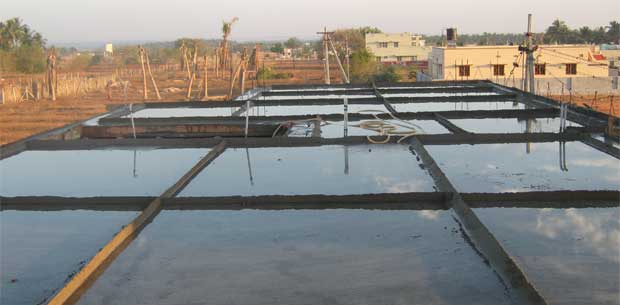Concrete gains its strength by the process of hydration, and the hydration needs water. Hydration is a continuous process. Meeting the requirements of water for hydration is done by curing. There are many methods of curing of concrete. Some of these methods are discussed here.
Water Curing:
Water curing is one of the most traditional and effective methods. It involves continuously wetting the concrete surface to prevent moisture loss during the critical initial curing period.
This method is commonly used for smaller projects or when other curing methods are impractical. Also, this method needs more water than other methods of concrete curing.
Read Also- Widely Used Concrete Admixtures (Concrete Technology)
Membrane Curing:
This method of curing involves using water-retaining barriers such as wet burlap, cotton mats, or curing compounds to shield the concrete surface from moisture loss. This method is suitable for large areas where constant wetting may be challenging or when a protective layer is required to prevent drying.
Steam Curing:
Steam curing accelerates the hydration process by applying heat to the concrete. This method is particularly useful in cold weather conditions or when a rapid strength gain is necessary. This method is commonly employed in precast concrete manufacturing or for structures that need to achieve high early strength.
Covering with Wet Sand/Straw:
In this method, the freshly poured concrete is covered with a layer of wet sand or straw to retain moisture and protect the surface from drying. This technique is often used in small-scale projects or in areas where alternative methods are not feasible.
Ponding:
Ponding involves creating small ponds or reservoirs on the concrete surface, ensuring continuous water contact for an extended curing period. It is suitable for horizontal surfaces like slabs, where maintaining a water source is feasible.
Polyethylene Sheeting:
Covering the concrete with polyethylene sheeting creates a barrier that prevents moisture evaporation, maintaining the required level of hydration. Polyethylene sheeting is commonly used in areas where water scarcity is an issue or when an economical and practical solution is needed.
Benefits of Curing of Concrete
- Curing of concrete results in impermeable concrete.
- This also results in the complete or tends to complete hydration of cement.
- Concrete curing prevents shrinkage strain at an early stage of the process of hydration.
Standard Codal References for Curing of Concrete
- ACI 308, American Concrete Institute – Guide to Curing Concrete
- BS 8110 – British Standard for the Design and Construction of Reinforced and Prestressed Concrete Structures
Conclusion:
Curing is necessary to accelerate the process of hydration of concrete. Indian standard recommends curing of concrete for at least 7 days.
Read Also-
Geopolymer Concrete: Properties and Benefits
Self-Compacting Concrete – Properties and Application
Lightweight Concrete – Making And Applications
